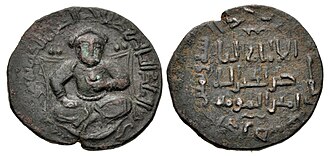

Nasir al-Din Artuq Arslan (ruled 1200–1239) was a ruler of the Artuqids of Mardin. The "Mardin branch" of the Artuqids ruled in Mardin and Mayyafariqin from 1101 to 1409, and were primarily descendants of Ilghazi and his brother Alp-Yaruq. His predecessor was his father Yuluq Arslan.
On the reverse of his coins dated AH 628 (1230 CE), Artuq Aslan inscribed the names of two overlords, the Abbasid Caliph al-Mustansir and the Ayyubid ruler al-Kamil. At that time, in 1229, the Ayyubids were allied with various Turkomans, including Artuq Aslan, in order to repel the offensive of the exiled Khwarazmshah ruler Jalal al-Din from his base in Armenia. They defeated Jalal al-Din and his Artuqid ally Rukhun al-Din Mawud (cousin of Artuq Aslan) in 1230.
The Ayyubids continued their expansion into Diyarbakr by attacking the Artuqid ruler Rukn al-Dīn Mawdūd (r.1222–1232/33) in his territories of Hisn Kayfa and Amid in 1231-1232. Around 1234, Artuq Aslan changed his allegiance to the Seljuk Rums, fearing further Ayyubid expansion into his territory of Mardin. The Ayyubids were defeated by the Seljuk Rums ruler Kayqubad I in 1234. The Ayyubids renounced retribution against Artuq Aslan when they learnt of the Mongol invasion of Jazira from the east.
The lands of the Artukid dynasty fell to the Mongol invasion sometime between 1235 and 1243. The Artuqids submitted to Mongol khan Hülegü and continued to govern as vassals of the Mongol Empire.
References
- Whelan Type XIII; S&S Type 48.2; Album 1830.11.
- Sinclair, Thomas Alan (1989). Eastern Turkey: An Architectural and Archaeological Survey, Volume III. The Pindar Press. p. 172. ISBN 978-1-904597-76-6.
- Eastmond, Antony (20 April 2017). Tamta's World. Cambridge University Press. p. 141. ISBN 978-1-107-16756-8.
- "Dirham of Nasir al-Din Artuq Arslan (r. 1200-1239)". The Metropolitan Museum of Art.
- ^ Künker, Fritz Rudolf. Künker Auktion 137 - The De Wit Collection of Medieval Coins, 1000 Years of European Coinage, Part III: England, Ireland, Scotland, Spain, Portugal, Italy, Balkan, the Middle East, Crusader States, Jetons und Weights. Numismatischer Verlag Künker. pp. 396–397.
- Spengler, William F.; Sayles, Wayne G. (1992). Turkoman Figural Bronze Coins and Their Iconography: The Artuquids. Clio's Cabinet. ISBN 978-1-879080-02-7.
In 1229 Jalal al-Din, the exiled Khwarazm Shah, began again to threaten the Ayyubids and their Turkoman alliesfrom his base in Armenia. The allies mounted a counter-offensive and, after several battles, defeated Jalal al-Din decisively late in 1230. Artuq Arslan supported the Ayyubids in this crisis, while the Artuqid cousin Rukn al-Din, ruler of Hisn Kayfa and Amid, made common cause with the Khwarazmshah.
- Ed. Morris Rossabi. China among equals: the Middle Kingdom and its neighbors, 10th–14th centuries, p. 244
- Bosworth, Clifford Edmund (2004). "The Artuqids". The New Islamic Dynasties: A Chronological and Genealogical Manual. Edinburgh University Press. ISBN 9780748696482.